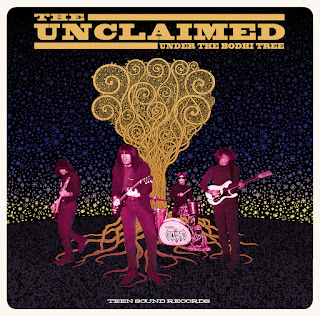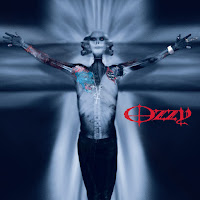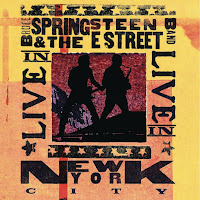The Unclaimed – Under the Bodhi Tree LP (Teen Sounds Records/Misty Lane Music, Italy)
The Unclaimed were one of the great lost bands of the 1980s garage-rock revival. Formed in Los Angeles in 1979 by singer, songwriter, and guitarist Shelley Ganz after he’d dropped out of UCLA, a chance meeting with musician Sid Griffin led (indirectly) to the formation of the Unclaimed. After a couple years spent treading the boards, Griffin and Ganz were at odds and ol’ Sid absconded with the band’s bass player, Barry Shank, and formed the Long Ryders, a beloved cult band that were leading lights of the L.A. “Paisley Underground” along with Steve Wynn’s Dream Syndicate and Matt Piucci’s Rain Parade. Ganz regrouped with new musicians, but the Unclaimed never really got off the starting line, represented today, as they are, by a pair of 12” EPs, one full-length album, and appearances on a bunch of compilation platters with names like Battle of the Garages (Voxx) and Garage Sale (ROIR). That lone Unclaimed album, Under the Bodhi Tree, has its own tale to tell; released in 1991 by the German Music Maniacs Records label, it was recorded and released under the band name ‘Attila + The Huns’, a pseudonym for the Unclaimed.
Under the Bodhi Tree sat on the shelf for five years before its 1991 release (and rapid disappearance), but it’s recently been rediscovered, recovered, and reissued on black wax with three bonus tracks by Italy’s Teen Sounds Records, Misty Lane Music’s reissue label. It’s a real gem, too – these guys couldn’t have sounded more like a bona fide ‘60s-era garage-rock if they’d stepped out of an Electric Prunes nightmare. Unclaimed frontman Ganz had a resounding ‘young, loud, and snotty’ voice, a cross between Sky Saxon and Scott Morgan, and in guitarist Dan Valentie he had a righteous string-bender who played like Duane Eddy on steroids and tequila. Bassist, keyboardist, and backing vocalist Lee Joseph (future founder of Dionysus Records) and drummer Scott Forer provided an imposing rhythm section.
As such, songs like “Well, It’s True,” with its trembling guitar licks and circular riff, the eerie exploitation film vibe of the instrumental “Village of the Giants,” or the shambolic “Great Mystery,” with its whiplash arrangement and tuff-as-nails vox, leap out of your speakers and grab you by the medulla oblongata. Ganz eventually disappeared from the music scene altogether, while various Unclaimed alumni moved onto another revivalist outfit, Thee Fourgiven, before scattering to the four winds...but they left us a single, über-cool LP to remember them by! Grade: A- BUY!
The Vipers – Outta the Nest (Teen Sounds Records/Misty Lane Music, Italy)
Hailing from the “Big Apple,” NYC’s The Vipers were one of the pioneering bands of the 1980s-era garage-rock revival. Outta the Nest, their 1984 debut disc, shows that they had the chops, attitude, and proper schooling in garage-psych-freakbeat styles to finesse their sound to a groovy pastiche that drew on the past even while looking towards the future. Singer Jonathan Weiss possessed a fine set of pipes, his vox snarling, snotty, and sneering but channeling just enough pop enthusiasm to avoid sounding menacing. David Mann and Paul Martin’s chiming, ringing guitars support the arrangements and jangle at just the right time while the rhythm section of bassist Graham May and drummer Pat Brown drive the beat forward impressively. All of the band members provide vocal harmonies, and several of the guys are multi-instrumentalists, so Outta the Nest is afforded a sprinkling of keyboards, harmonica, harpsichord, and bongos to fatten and deepen the album’s sonic imprint.
Reissued on vinyl in 2022 by our friends at Teen Sound Records in Italy, Outta the Nest sounds fantastic, while the co-production by Blondie/Patti Smith Group cohort Ivan Kral, is wonderfully crystalline, capturing the sort of instrumental nuances that heighten the listening experience. It’s the songs that count, however, and the Vipers’ delivered some good ‘uns for Outta the Nest, from the infectious pop-rock of “Tellin’ Those Lies” or the ominous, psych-drenched “Medication” with its cool organ riffs, eerie vocals, and wiry guitar licks to the locomotive Yardbirds doppelganger “Ain’t Nothin’ Like Her” or the blues-tinged, up-tempo title track. The Teen Sound reissue includes four bonus tracks – fewer than the 2000 Cavestomp CD reissue but more than on my original vinyl copy – including the epic instrumental “Now I Remember,” which showcases the band’s skills nicely. If you haven’t heard the Vipers before, you should glom onto ‘em now...RIYL The Chesterfield Kings, The Miracle Workers, or The Cynics. Grade: A BUY!
















